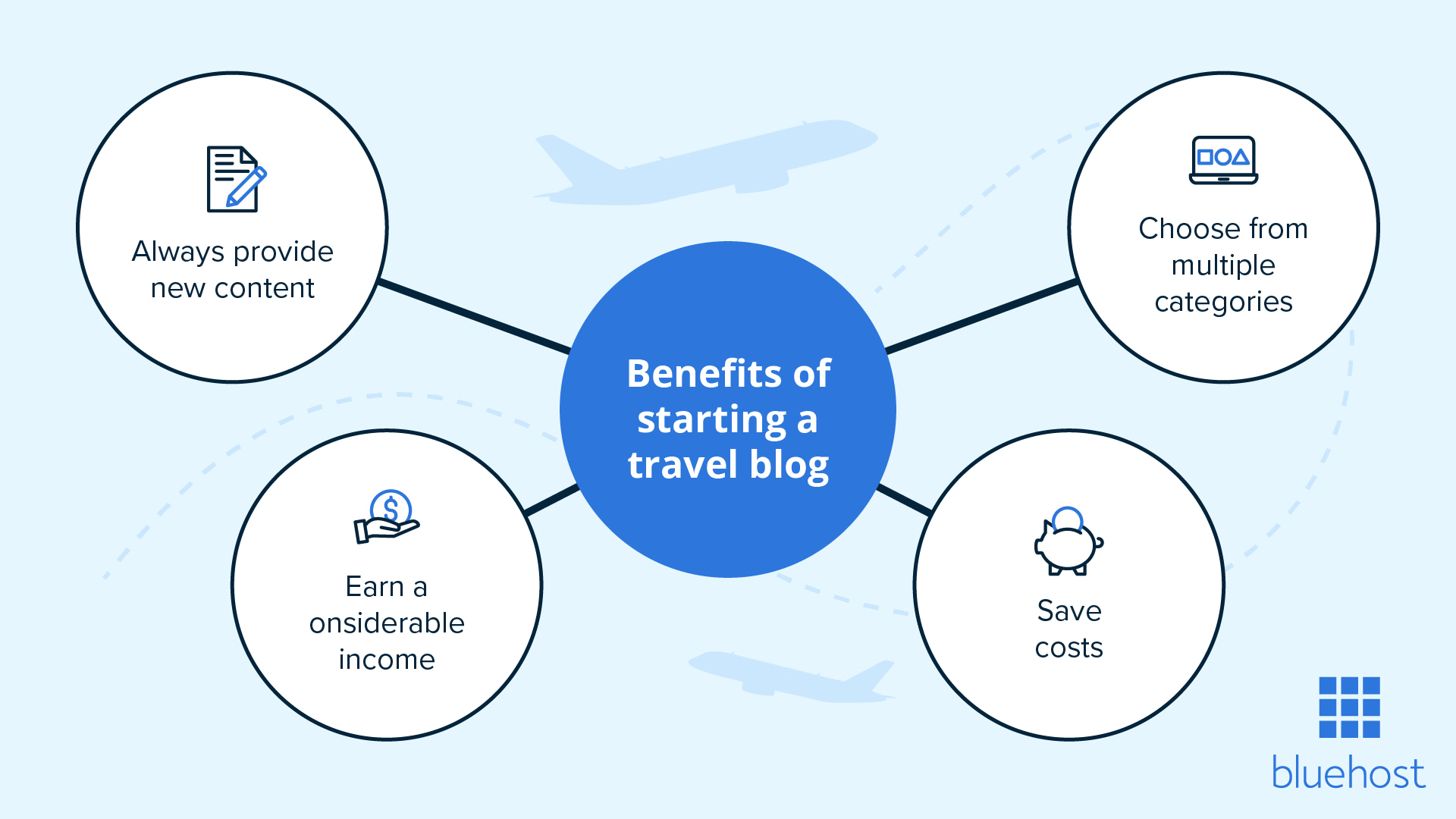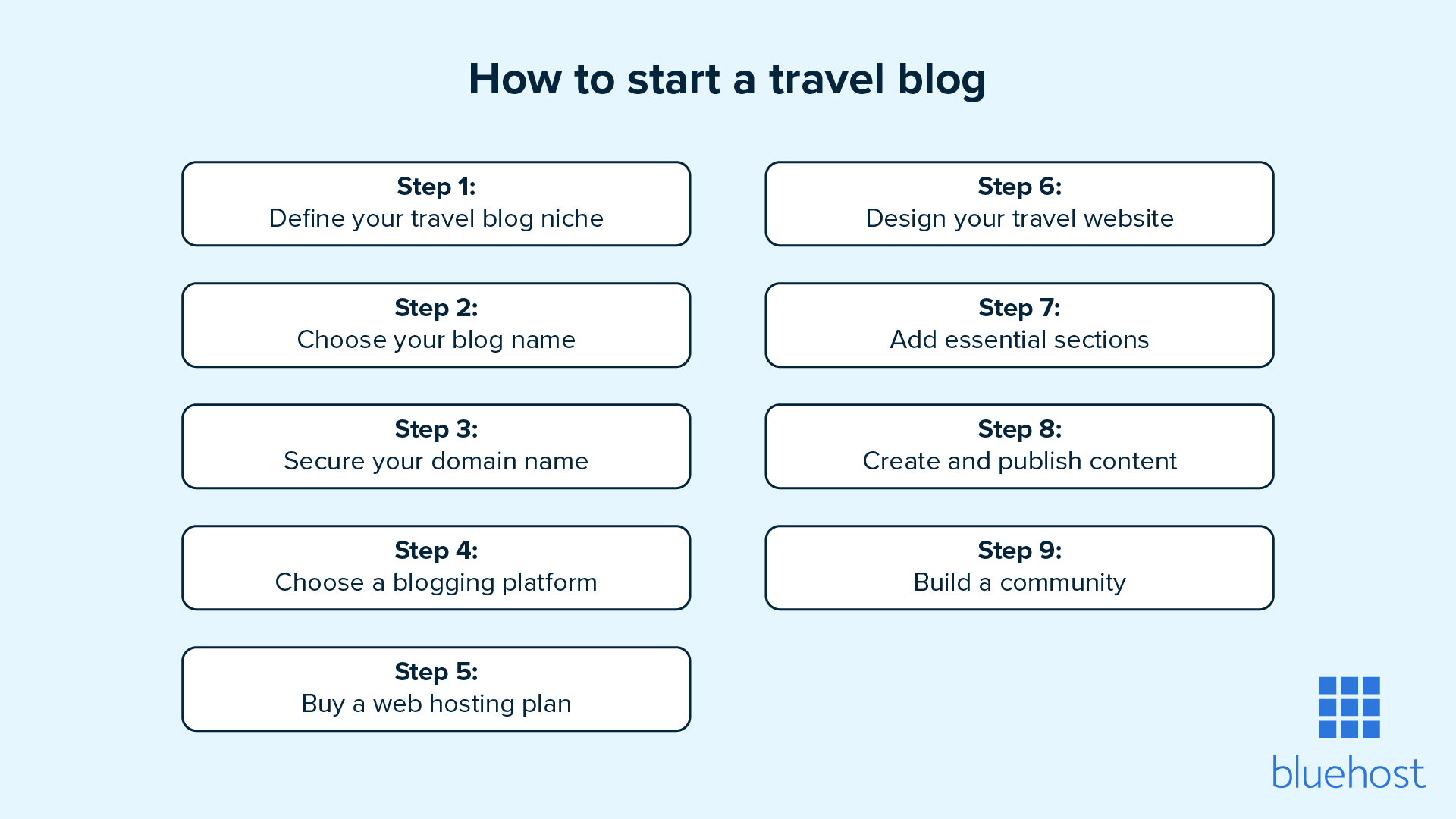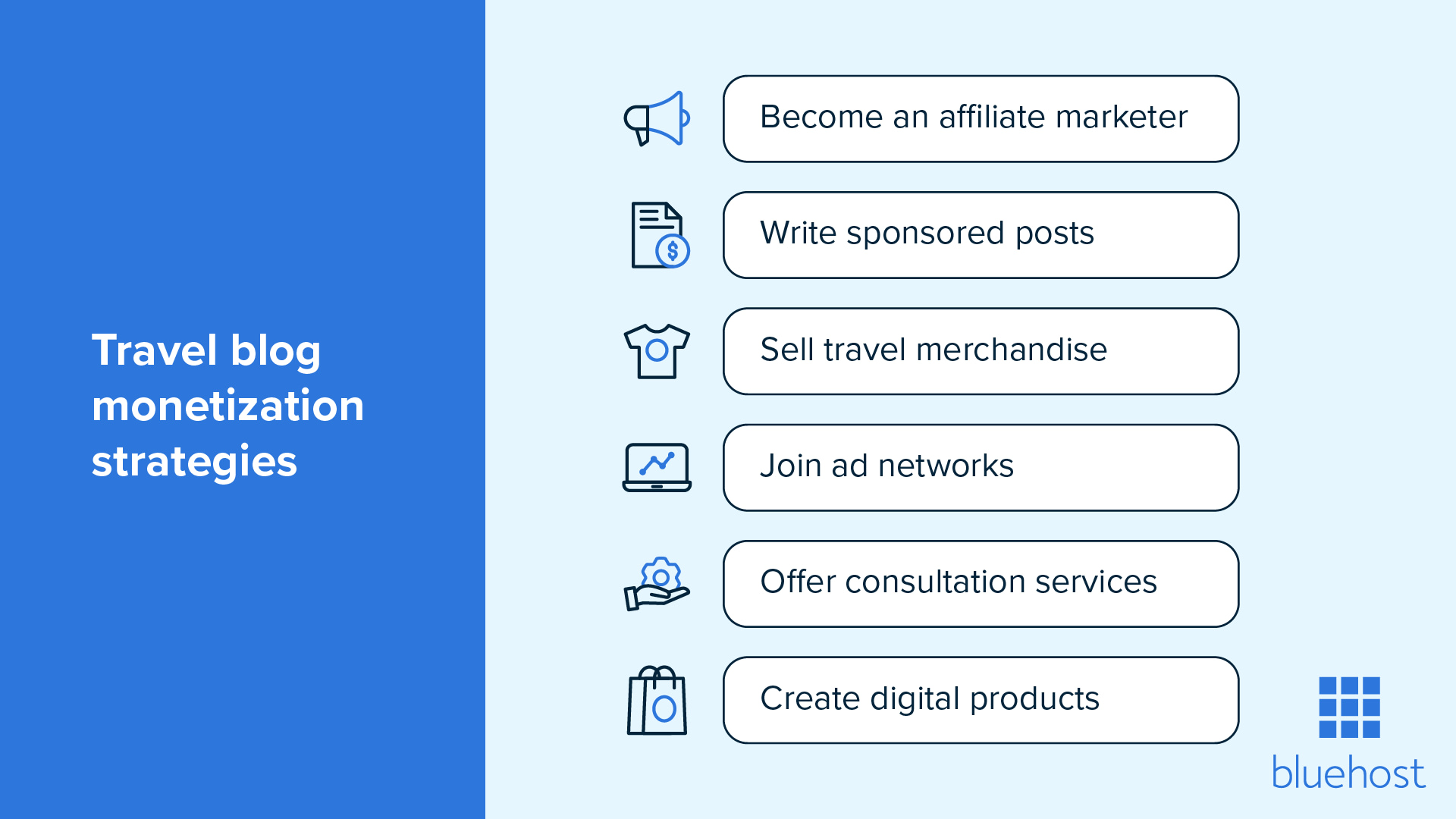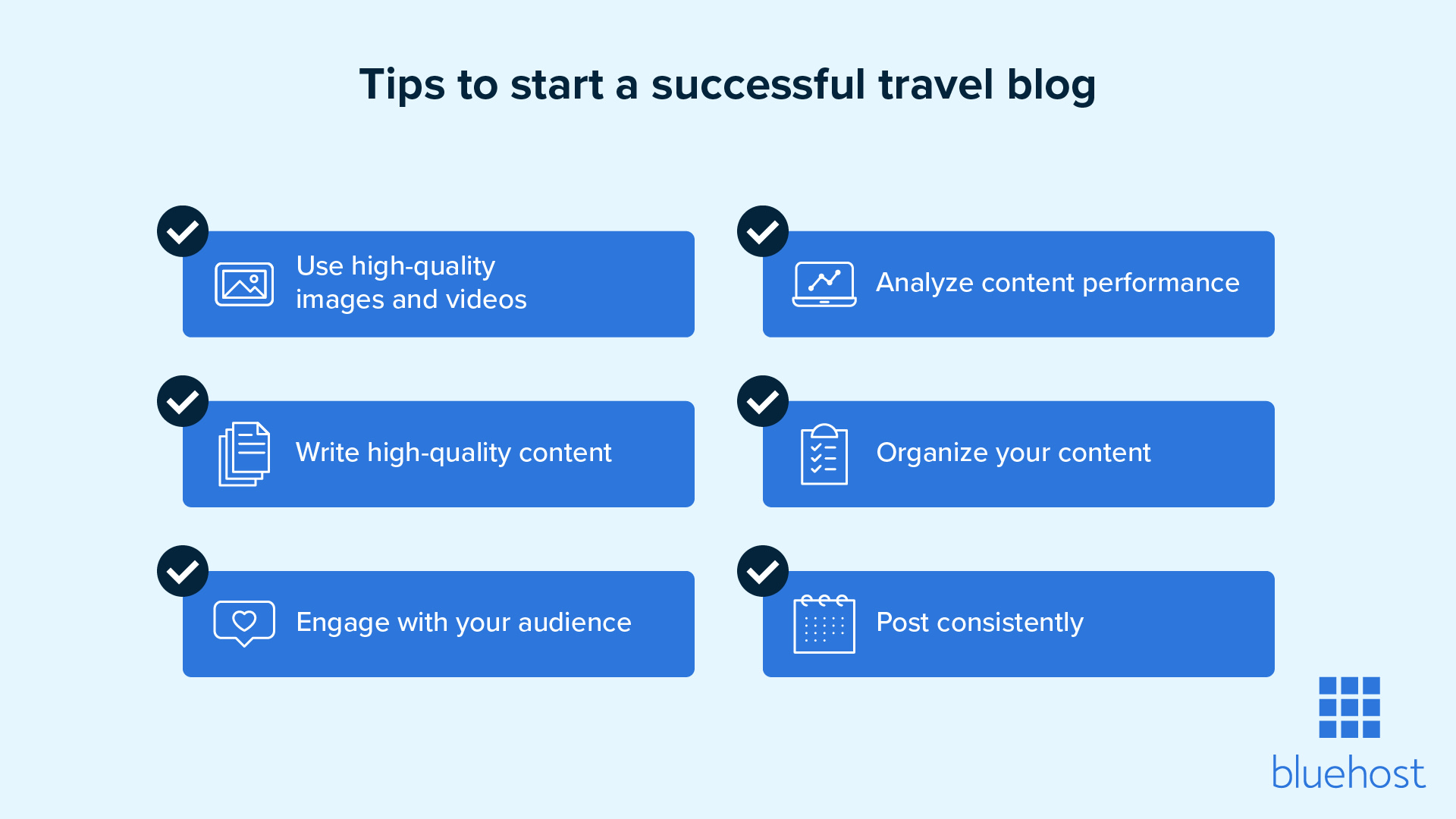Starting a travel blog is one of the best ways to earn money in 2024. According to Expedia, 49% of travelers head online for travel tips, making it one of the best niches for monetization as a new blogger.
However, travel topics are highly competitive, with the internet boasting thousands of travel blogs. To stand out among these websites and earn a reliable income, you must further niche down and follow a well-planned strategy.
This guide reveals how to start a travel blog, best practices for success and various ways to make money blogging.
Why you should start a travel blog
With the high number of travel blogs in existence, it’s natural to wonder if this niche is worth it.
But while the number of travel bloggers is increasing, tourism is also becoming more popular. According to RankIQ, travel is one of the four highest-traffic niches, which means that with the right strategy, you can generate monetizable traffic and boost revenue growth.
By creating a travel blog, you can:

Always provide new content
Travel is a dynamic blog niche. Even if you’re writing about the same destination, things might be much different in a few years. New restaurants might have popped up, or your favorite tourist spot might have updated its amenities.
As travelers constantly look for the latest information, there’s an endless list of unique topics to write about.
Choose from multiple categories
Travel is a vast niche with many sub-niches. For instance, some bloggers document their travel journeys, while others only write about food and restaurants in different locations.
Few bloggers also choose to cover only offbeat locations or lesser-known vacation spots. You can approach travel blogging in multiple ways and cover only sub-niches you’re comfortable with.
Earn a considerable income
Travel writers in the U.S. earn $50,000 per year on average, indicating that travel blogging can be a full-time job.
There are multiple ways to monetize travel blogs, so you can earn active and passive income from a single source.
And, thanks to the surging popularity of travel blogs, you can drive traffic to your website using a combination of free and paid digital marketing strategies, increasing your overall earning potential.
Save costs
If you’re an avid traveler, starting a travel blog helps you earn as you go, ultimately saving costs. Many tourism companies, hotels and restaurants work with influencers and bloggers to market their brands.
You can get collaboration opportunities and sponsorships for accommodation and travel, cutting down on expenses while enjoying your dream vacation.
Now that you know the benefits of travel blogging, let’s consider how to start your blogging journey.
How to start a travel blog
Like most websites, travel blogs have specific requirements to attract visitors and generate higher revenue.
Here’s a step-by-step guide on how to start a travel blog and make money online.

Step 1: Define your travel blog niche
You can write about several sub-niches that appeal to travel enthusiasts. These include tourist destinations, itineraries and food. However, if you try to cover multiple niches in a single blog post, your website might become too general.
This can lead to a poor user experience as it may be difficult for your audience to find a topic they’re interested in. To enhance the user experience and stand out among competitors, you need to focus on a single niche.
Niching down helps you attract quality leads who are interested in your content and might convert easily.
When choosing a niche, opt for one you’re interested in, has a high demand and fits your budget.
If you’re unsure about how to choose, here are a few options:
- Based on location: Consider writing about local or international tourism.
- Based on activity: Adventure tourism, wellness retreat and wildlife tourism are a few options to choose from.
- Based on cost: Options include budget travel and luxury travel.
- Based on season: Write about iconic winter campgrounds or summer destinations.
Once you’ve chosen the best travel niche, it’s time to breathe life into your blogging business.
Step 2: Choose your blog name
Your blog name creates your audience’s first impression of your online business. Ensure your blog name is unique and appropriately reflects your brand.
For example, if you’re a solo traveler, you can name your blog “The Lone Traveler” or “Wanderlust & I.” Similarly, you can also include your name to personalize your brand. The travel blogger Nomadic Matt is an excellent example to inspire you.
Step 3: Secure your domain name
Once you’ve chosen your travel blog name, register it as your website domain. However, if your chosen blog name isn’t available as a domain name, consider using a variation.
You can use Bluehost’s domain checker to search and register your desired domain name.
At Bluehost, we provide several domain extensions, including .com, .org, .info and .net, so you can choose popular extensions or go for something more specific to your brand.
Step 4: Choose a blogging platform
A blogging platform is essentially any software that allows you to create, customize and manage your own travel blog. You can either opt for a content management system (CMS) or a website builder.
A website builder allows you to create and customize a blog using pre-designed templates and drag-and-drop functionality. On the other hand, a CMS enables you to create and manage website content but may require some technical knowledge.
If you opt for a CMS such as WordPress, you can accelerate the design process by purchasing a WordPress hosting plan in the next phase of starting your travel blog.
Step 5: Buy a web hosting plan
Web hosting is an essential service that helps your website go live. Like any other website, your new travel blog also needs web hosting to become accessible online.
You’ll find several companies that provide web hosting services. However, some might provide poor services or quote inflated prices and may not offer the protection you need.
To avoid performance or security issues, choose a reliable web hosting company like Bluehost that provides secure web hosting and round-the-clock support through live chat.
With our WordPress hosting plans, you don’t need to install WordPress — it comes pre-installed. But with other web hosts, you may need to install your chosen blogging platform yourself.
Step 6: Design your travel website
Once you’ve installed your blogging platform, it’s time to customize your website. A well-planned website layout is visually appealing and helps visitors navigate with ease.
WordPress offers myriad templates and plugins to help you customize your website, even if you’re a beginner. Plus, it’s easy on the pocket compared to hiring a professional web designer.
The platform has a large collection of free blog themes you can apply through your WordPress dashboard. You can further customize the color, font or layout of these free themes to suit your website’s requirements.
If you need more options, purchase premium themes or hire a professional designer to create a customized template for your WordPress blog.
Step 7: Add essential sections
Apart from the homepage, contact page and blog, you’ll need to add other essential sections to your website.
Consider adding a Comment box under every article, categorizing different types of travel content and creating a dedicated section for images and videos.
WordPress also has travel-related plugins to add new features and enhance your website’s functionality. For instance, you can add maps and location-based content using WordPress plugins like Travel Map and Geo Mashup.
Step 8: Create and publish content
Now that you know how to start a travel blog, it’s time to publish your first blog post.
Start by choosing a niche topic. This can be something about a recent trip you took, an itinerary for your dream vacation or places to visit in the coming months.
Need more inspiration? Scroll through your competitors’ social media pages or use tools like Google Trends to discover new travel topics.
Write the blog in your unique style, but ensure that all the information is well-documented and accurate. Include high-quality images and videos to keep the content highly engaging.
Also, add relevant links and locations wherever possible so readers can easily access the places mentioned in your blog.
Don’t forget to optimize your blog content for search engines. Search engine optimization (SEO) helps your posts rank higher on Google Search and generate organic traffic, ultimately leading to higher revenue.
Tools like Yoast SEO and Clearscope can help you create engaging content that ranks high in search engines.
Step 9: Build a community
You can use your travel blog to build an online community of regular readers or fellow travel enthusiasts. Creating a community makes it much easier to connect with readers and build a positive brand image.
Use email marketing and online forums to build your community. You can also ask readers to connect with you on social media platforms.
Interact with your community members and provide exclusive content that delivers value.
The above tutorial teaches you how to start a travel blog. However, just posting travel content and increasing blog traffic isn’t enough. Converting this traffic into revenue requires hard work, consistency and a winning strategy.
Strategies to monetize your travel blog
Travel blogging gives you access to multiple monetization strategies that make it easier to earn a sustainable income.
Here are the most popular strategies you can use to earn money as a travel blogger:

1. Become an affiliate marketer
Affiliate marketing involves partnering with travel brands or product-based companies to place links on your blog and earn a specified amount for each sale you generate. Brands like Amazon and Booking.com offer affiliate programs that can help you make money as a blogger.
As an affiliate marketer, you can earn $47,000 per year on average. The best part is that you won’t incur any losses even with minimum sales, as you don’t have to hold any inventory.
2. Write sponsored posts
Writing sponsored posts (and guest posts) is another excellent way to partner with travel companies and earn money blogging. Travel aggregators, hotels and tourism boards offer partnerships to successful bloggers to market their brands through sponsored posts.
Travel bloggers usually charge between $250 and $3,000 for a single sponsored article. Unlike affiliate marketing, sponsored posts don’t operate on a commission basis. You’ll earn a fixed amount upfront, regardless of the number of sales you generate.
3. Sell travel merchandise
If you have a loyal community, you can sell travel merchandise to earn money online. Profitable merch to sell includes backpacks, trekking poles, water bottles and other items with your logo.
You can either produce these items in bulk and maintain an inventory or choose a print-on-demand route to keep investments and risks at a minimum.
4. Join ad networks
Ad networks like Google AdSense and Mediavine pay commissions for clicks and sales in exchange for ad space. If you’ve got consistent traffic on your travel blog, you can sign up on these platforms and display multiple ads on your website.
Bloggers who make more than $7,500 per month earn 33.3% of their income through ads. While ads are a great way to monetize your blog, too many ads can overwhelm visitors and deter them from returning.
As a best practice, limit the number of ads you display per page to ensure visitors have a positive user experience on your blog.
5. Offer consultation services
Many people who visit travel blogs still need help to plan their trips. You can offer consultation services to such users and plan their accommodation, itineraries and transport using your travel expertise.
6. Create digital products
Along with travel merchandise, you can sell digital products such as travel guides, blogging courses, checklists, printables and booking apps. You can market these products exclusively to your community to create a reliable source of passive income.
Best practices for running a successful travel blog
Even if you implement the most profitable blog monetization strategy, you’ll need consistent traffic to earn a decent sum.
Here are a few tips to help you become a successful travel blogger:

Use high-quality images and videos
High-quality graphics keep readers engaged and help them visualize their travel plans better than reading only the text.
Adding images and videos to your travel articles also attracts travelers who choose their destinations based on the location’s visual appeal.
Write high-quality content
While there are thousands of travel blogs in existence, you can stand out from the competition by creating high-quality content. Brainstorm ways you can make your blog unique.
For instance, you can write about your travel experiences to keep the content authentic. Make your blog a one-stop destination by covering everything from transportation to location and accommodation so readers don’t have to look elsewhere.
Engage with your audience
Interact with readers by responding to their comments and queries under your posts. Consider addressing any questions or ideas from these comments when you create a new post.
Make sure to weed out spam comments to keep your website clean and create a safe user experience.
If you’ve built a community, engage your target audience with Q&A sessions, exclusive content and other incentives.
Analyze content performance
Regularly analyze your content’s performance by monitoring the number of clicks, impressions, traffic and comments you get.
With tools like Google Analytics, you can identify top-performing content, monitor user behavior and create great posts that generate organic traffic.
Organize your content
Organizing your content plays a pivotal role in keeping your audience engaged. If your blog posts are disorganized and difficult to read, website visitors may lose interest and switch to a competitor.
Here’s how to organize your content and enhance readability:
- Use short paragraphs with two to three lines: Well-spaced paragraphs are easier to read than large blocks of text.
- Break up text with high-quality graphics: These include images, videos, tables and infographics. To save costs, use free tools like Canva to create unique graphics.
- Divide the content using subheadings: This helps readers find the information they want by referring to the headings.
- Organize content in different formats: This involves using bullet points, bold texts and italics to highlight important information and improve readability.
Post consistently
As millions of people travel throughout the year, posting consistently helps your blog stay relevant. It also provides your audience with a reliable source of information for their travel plans.
Publish a new post every week or at least once every two weeks. You can also split a single topic into multiple articles to keep your audience hooked. For example, you can write about the itinerary, food and outdoor activities of a particular vacation spot in three different articles.
Final thoughts: How to start a travel blog and make money in 2024
If you’re a travel enthusiast, starting a travel blog is a great way to earn a sustainable income while doing something you enjoy. Plus, there’s no shortage of new topics to write about, regardless of your travel niche.
However, to keep your blog running without any hiccups, you’ll need reliable and budget-friendly website hosting. Bluehost provides secure web hosting, complete with the required tools and plugins to run a successful blog and start earning money.
So you can focus on creating high-quality content for your blog while we handle the back end.
Ready to make money as a travel blogger? Check out Bluehost’s WordPress hosting plans.
How to start a travel blog: FAQs
Yes. Travel blogs are a popular blog niche and can generate a sustainable income for people who love to travel. Starting your blogging journey requires minimal investment and can generate thousands of dollars in ROI annually.
While traveling helps you add authentic experiences to your blog, it’s not mandatory. You can start a travel blog by gathering information from the internet, compiling lists of popular places or drawing inspiration from the travel experiences of people around you.
Yes. Starting a travel blog doesn’t require a lot of money. You can build a free blog using a CMS like WordPress. Combine it with Bluehost’s budget-friendly hosting plans, and you’ll have a live travel blog with little investment.
Plus, you’ll get a free domain name for the first year when you leave your WordPress hosting to us, so you don’t have to spend money on domain name registration.
To start a travel blog, you’ll need a website with a dedicated blog section and a domain name suitable for your business. You’ll also need a hosting plan with considerable storage to accommodate the high-quality images and videos you plan to upload.
The post A Step-by-Step Guide To Creating Your Own Travel Blog appeared first on Bluehost Blog.
[ad_2]
Article link
